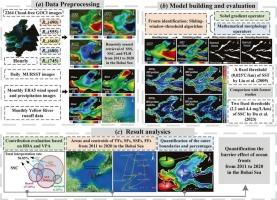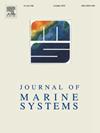气候变暖和黄河径流增加削弱了海锋对中国渤海陆地悬浮泥沙和营养物质输送的屏障作用
IF 2.5
3区 地球科学
Q2 GEOSCIENCES, MULTIDISCIPLINARY
引用次数: 0
摘要
海洋锋的屏障效应得到了普遍的认识,但很少被量化。本研究旨在量化气候变化下中国渤海的这种屏障效应。首先,借助基于goci的遥感检索和辅助数据产品,通过对比不同水动力因子(温度、盐度、降水、径流和风速)对悬沙浓度(SSC)和荧光线高度(FLH)的贡献率,验证了这种屏障效应。其次,采用滑动窗口阈值算法(SWTA)获取2011 - 2020年的OFs、悬浮泥沙锋(SSFs)和荧光锋(FFs)面积;第三,基于形态学开放滤波得到OFs的外边界,生成涉及海岸线的封闭区域;最后,将整个渤海海域的海洋资源和海洋资源划分为高价值、过渡性和低价值三类。进一步利用封闭区域所涉及的三类百分比来量化屏障效应。结果表明:屏障效应减弱的主要原因是:1)浮叶面积减少3.17 × 103 km2,浮叶面积增加9.67 × 103 km2;2) ssf质心向黄河口方向移动,FFs质心向近海移动;(3)封闭区域内涉及的过渡性、低价值类型的SSC和FLH比例分别为41.45%和37.58%。2011 - 2020年,海温变暖和黄河径流量增加共同导致渤海OFs屏障效应减弱。本文章由计算机程序翻译,如有差异,请以英文原文为准。

A warmer climate and an increased Yellow River runoff weakened the barrier effect of ocean fronts on the transport of terrestrial suspended sediment and nutrients in the Chinese Bohai Sea
The barrier effect of ocean fronts (OFs) was generally acknowledged but rarely quantified. This study aimed to quantify this barrier effect in the Chinese Bohai Sea under climate changes. Firstly, with the help of GOCI-based remotely sensed retrieval and ancillary data products, we verified this barrier effect based on the contrast of contribution rate of different hydrodynamic factors (temperature, salinity, precipitation, runoff and wind speed) on suspended sediment concentration (SSC) and fluorescence line height (FLH). Secondly, sliding window threshold algorithm (SWTA) was used to obtain the areas of OFs, suspended sediment fronts (SSFs), and fluorescence fronts (FFs) from 2011 to 2020. Thirdly, we obtained outer boundaries of OFs based on morphological opening filter, and to generate closed areas involving coastline. At last, SSC and FLH in the whole Bohai Sea were divided into three categories: high-value, transition, and low-value. Percentages of three categories involved in the closed areas were further used to quantify the barrier effect. The results showed that the barrier effect was weakened due to: 1) the area of OFs decreased by 3.17 × 103 km2, while that of FFs increased by 9.67 × 103 km2; 2) centroid of SSFs moved away from the Yellow River estuary, while that of FFs moved offshore; 3) percentages of transition, and low-value categories of SSC and FLH involved in the closed areas increased (41.45 %, 37.58 %). The warmer SST and the increased Yellow River runoff jointly led to the weakened barrier effect of OFs in the Chinese Bohai sea from 2011 to 2020.
求助全文
通过发布文献求助,成功后即可免费获取论文全文。
去求助
来源期刊

Journal of Marine Systems
地学-地球科学综合
CiteScore
6.20
自引率
3.60%
发文量
81
审稿时长
6 months
期刊介绍:
The Journal of Marine Systems provides a medium for interdisciplinary exchange between physical, chemical and biological oceanographers and marine geologists. The journal welcomes original research papers and review articles. Preference will be given to interdisciplinary approaches to marine systems.
 求助内容:
求助内容: 应助结果提醒方式:
应助结果提醒方式:


